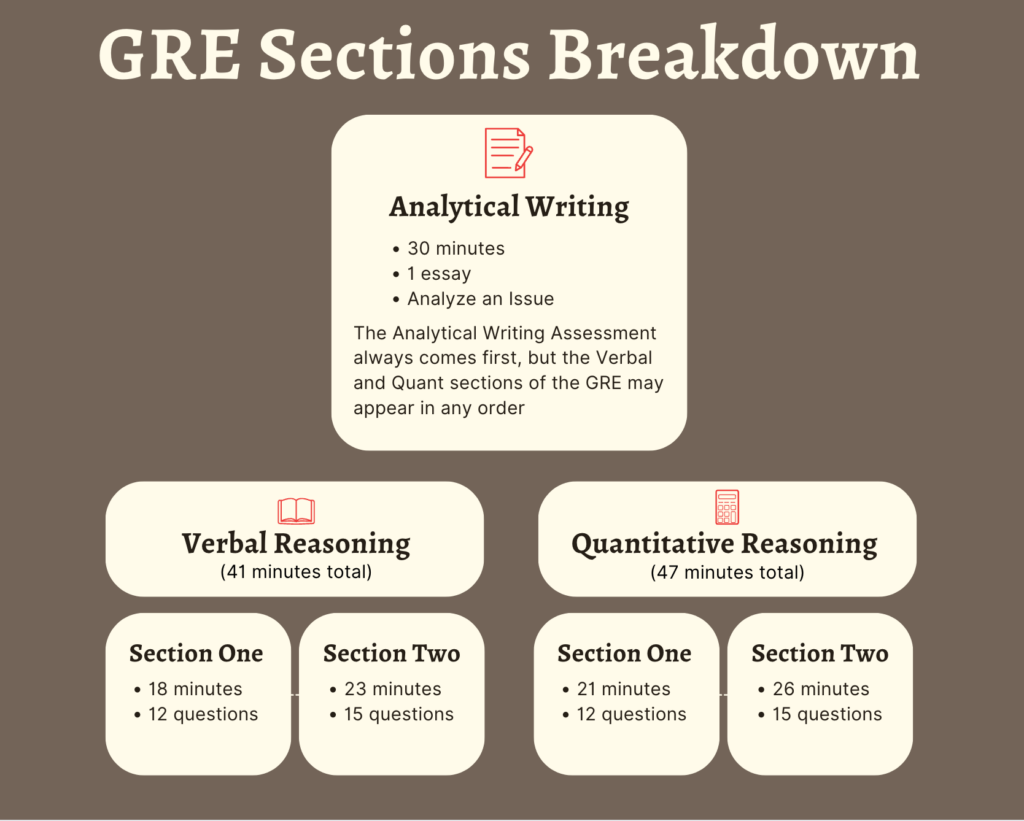Before taking the GRE (Graduate Record Examination), it is important to have a good understanding of the sections of the exam. In addition to preparing for the actual material covered in each of the GRE sections, you must understand how to approach each GRE question and leverage your time.
In this article, we’ll break down the exam at the section level, the content covered in each GRE section, and the timing of the exam.
The GRE is a computer-delivered test made up of five sections:
The Analytical Writing section always comes first, and the Verbal Reasoning and Quantitative Reasoning sections can come in any order after that. Regarding timing, test takers are given 1 hour and 58 minutes to complete all three GRE test sections.
Except for the Analytical Writing, the rest of the sections mostly contain multiple choice questions from which you have to pick the correct answer(s). You can refer to our official GRE practice questions for further information on the types of questions on the GRE.
The next part of this article gives a bit more detailed information about each of the GRE sections.

The Analytical Writing (AW) measure of the exam has one section with one “Analyze an Issue” task, requiring test takers to provide a focused response to an opinion.
The Analytical Writing section lasts 30 minutes and measures your ability to clearly communicate complex ideas, reinforce these ideas with concrete examples, and produce a coherent discussion to support your response.
Despite what its positioning on the exam might suggest, this section is the least important to MBA admissions committees.
The Verbal Reasoning (Verbal) measure of the GRE is composed of two sections. The sections are two separately timed tasks.
The Verbal Reasoning portion of the exam is section-level adaptive, meaning that the first section to appear will be of average difficulty and the difficulty of the second section will depend on your performance in the first.
For example, if you got more questions right in the first section, the next section will be harder. While if you got fewer questions right in the first section, the second section will be less difficult.
In the Verbal Reasoning portion of the exam, questions test your knowledge of the English language alongside your ability to decipher relationships among different words and sentence components.
The types of questions include:
The Verbal portion of the GRE includes multiple-choice questions (selecting one or more correct answers) and text selection questions (highlighting a portion of the provided text).
The Quantitative Reasoning (Quant) measure of the exam is made up of two sections, which are also separately timed.
Test takers are provided with an on-screen calculator during the Quantitative Reasoning sections of the exam.
Like the Verbal reasoning section, the Quantitative Reasoning section is section-level adaptive, meaning the difficulty level of the second section is dependent on your performance on the first.
This portion of the GRE requires test takers to understand various mathematical concepts, including arithmetic, algebra, geometry, linear and quadratic equations, and data analysis.
However, your ability to analyze and interpret quantitative information is also being tested. Therefore, test takers need to use the right strategy to tackle these not-so-straightforward math questions.
The Quantitative Reasoning measure of the exam has three types of questions—all of which are designed to test your knowledge of key math principles in different ways.
The Quant portion of the GRE exam includes multiple choice questions (selecting one or more answer choices), quantitative comparison questions, and numeric entry questions.
There are three portions of the GRE exam: Analytical Writing, Verbal Reasoning, and Quantitative Reasoning.
The Analytical Writing portion of the exam makes up one section, while the other two portions (verbal reasoning, quantitative reasoning) are further divided into two sections each.
There are, therefore, five total sections of the GRE, which can be broken down as follows:
Of course, understanding the different sections of the GRE is only one small part of test prep.
We recommend doing some research into what constitutes a “good” GRE score for you and developing a comprehensive GRE study plan to maximize your test prep.
Of course, working with an expert GRE tutor will allow you to develop a comprehensive understanding of both the exam itself and the content and strategy necessary to achieve your target scores.
Explore the GRE exam sections in-depth with Menlo Coaching’s GRE tutoring program, helping you tackle every question type with confidence.